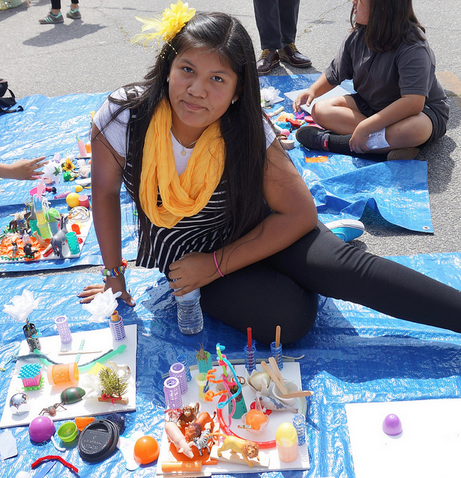
Wider sidewalks, bike paths, fewer car lanes, park space.
These were some of the ideas that Scarlet, a participant in James Rojas' interactive workshop focused on thinking of a new design for North Figueroa Street, presented to the group. The eight-year-old was the team leader for one of two tables set up for the workshop, which happened to include me and local bike-celebrity, Josef Bray-Ali. By the time we were done, we had designed a street for 2050 that was much smaller than the current five-lane mini-freeway that exists today.
At the same time advocates and residents were engaging with Rojas and Scarlet, Councilmember Gil Cedillo was working away at an alternative to the LADOT's previously-approved proposal to both put North Figueroa on a road diet and add more road diets. Cedillo's plan calls for Sharrows to be placed on side streets and minor improvements to the crosswalk design on North Figueroa.
The contrast between what we'll call the Cedillo Plan and the Scarlet Plan couldn't be more stark.

This is an ongoing theme of Rojas' workshops when the participants are high-school aged or younger. They want to see a transportation network that provides safe and attractive options for all road users. When politicians think of transportation planning, too often they still think of how to best move the most cars as quickly as possible.
The April 26 "Fig4All Interactive Planning Workshop" was the last of ten workshops conducted by the Southern California Streets Initiative and Place It! throughout the month. The other events, held at Roosevelt High School and in Pacoima with super-group Pacoima Beautiful, were designed to help the Goldhirsh Foundation get feedback for on its Goals for #LA2050.
These goals include:
- LA is the Best Place to Learn
- LA is the Best Place to Create
- LA is the Best Place to Play
- LA is the Best Place to Connect
- LA is the Healthiest Place to Live
There was a lot of enthusiasm from all participants for a plan that includes placing more emphasis on after-school programs, clean air, safer streets, more open space, and more transportation options. The workshops focused on the street designs, so we received the most feedback related to complete streets, open space and public safety.
Not one person of any age argued that Los Angeles needed more space for cars, wider streets, or faster car commute times. Not. One.
Of course, these are near-universal truths. You would be hard-pressed to find someone who is not a member of the Los Angeles City Council who thinks we need fewer transit options, and even then it's hard to imagine someone opposing after-school programs.
So, the lesson learned wasn't just that young people want better, safer, streets that support the environment, mobility, and having places to come together...but that there's a strong disconnect between young people and these goals and some of our decision makers.

I’m not saying that we need to hand over planning decisions to our children, but there’s clearly a major gap between what future generations want and what we’re planning to leave them. Building the city of the future necessitates inclusion of the voices of today's younger residents, tomorrow's city dwellers.
How to best do that is the million dollar question.
In Boyle Heights, City Planning's David Somers attended a second set of workshops on April 25. After the workshop, Somers and teacher Gene Dean discussed the possibility of having both he and two of his students participate in the city-sponsored roundtable regarding the future of Soto Street. Sahra Sulaiman will have more on the second set of workshops later this week.
If you can think of a better plan, leave it in the comments section.






